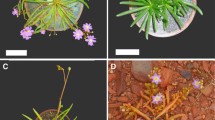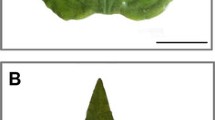Abstract
In the crassulacean acid metabolism (CAM) plant Kalanchoë daigremontiana, the internal CO2 concentrations were measured throughout CAM cycles by gas chromatography. Under normal dark-light cycles, the internal CO2 concentration was near that of the ambient air and increased up to 0.5% during the phase of maximum malate decarboxylation. A sharp increase in internal CO2 concentration occurring after the first 12 h of the cycle was exhibited by the plants both when there was a normal day-night cycle and when the night was replaced by illumination, and also when the light period was replaced by darkness. Thus, the increase in internal CO2 in the morning does not appear to be primarily determined by a light-on signal or by alterations of temperature rather than by inherent factors of the leaves. This view is supported further by a steep increase in 14CO2 production from labeted malate occurring during extended darkness at a time when the light period would normally begin. The results are discussed in particular in relation to of how CAM can control stomata movement.
Similar content being viewed by others
Abbreviations
- CAM:
-
Crassulacean acid metabolism
References
Cockburn, W., Ting, I.P., Sternberg, C.O. (1979) Relationship between stomatal behavior and internal carbon dioxide concentration in Crassulacean Acid Metabolism plants. Plant Physiol. 63, 1029–1032
Hohorst, H.J. (1970) L-malate estimation with malatedehydrogenase and NAD. In: Methods in enzyme analysis, vol II, pp. 1544–1548, Verlag, Chemie, Weiheim
Kluge, M. (1968) Untersuchungen über den Gaswechsel von Bryophyllum während der Lichtperiode. II. Beziehungen zwischen dem Malatgehalt des Blattgewebes und der CO2-Aufnahme Planta 80, 359–377
Kluge, M. (1969) Veränderliche Markierungsmuster bei 14CO2-Fütterung von Bryophyllum tubiflorum zu verschiedenen Zeitpunkten der Hell-Dunkel-Periode. I. Die Fütterung unter Belichtung. Planta 88, 113–129
Kluge, M. (1977) Regulation of carbon dioxide fixation in plants. In: Integration of activity in the higher plant. Symp. of Soc. Expt. Biol., vol. XXXI, Jennings, D.H. ed., Cambridge University Press, Cambridge New York Melbourne
Kluge, M., Fischer, K. (1967) Über Zusammenhänge zwischen dem CO2-Austausch und der Abgabe von Wasserdampf durch Bryophyllum daigremontianum Berg. Planta 77, 212–223
Kluge, M., Heininger, G. 1973: Untersuchungen über den Efflux von Malat aus den Vacuolen der assimilierenden Zellen von Bryphyllum daigremontianum und mögliche Einflüsse dieses Vorganges auf den CAM. Planta 113, 333–343
Kluge, M., Ting, I.P. (1978) Crassulacean Acid Metabolism: Analysis of an ecological adaptation. Ecological Studies Vol. 30, Springer-Verlag, Berlin Heidelberg New York
Lange, O.L., Medina, E. (1979) Stomata of the CAM plant Tillandsia recurvata respond directly to humidity. Oecologia 40, 357–364
Lüttge, U., Ball, E. (1978) Free running oscillations of transpiration and CO2 exchange in CAM plants without a concomitant rhythm of malate levels. Z. Pflanzenphysiol. 90, 69–77
Lüttge, U., Ball, E. (1979) Electrochemical investigations of active malic acid transport at the tonoplast into the vacuoles of the CAM plant Kalanchoe daigremontiana. J. Membr. Biol. 47, 401–422
Lüttge, U., Kluge, M., Ball, E. (1975) Effects of osmotic gradients on vacuolar malic acid storage. A basic principle in oscillatory behaviour of CAM. Plant Physiol. 56, 613–616
Morel, C., Queiroz, O. (1978) Dawn signal as a rhythmical timer for the seasonal adaptive variation of CAM: a model. Plant Cell Environ. 1, 141–150
Osmond, C.B. (1978) Crassulacean acid metabolism: a curiosity in context. Annu. Rev. Plant Physiol. 29, 379–414
Osmond, C.B., Ludlow, M.M., Davis, R., Cowan, I.R., Powles, S.B., Winter, K. (1979) Stomatal responses to humidity in Opuntia inermis in relation to control of CO2 and O2 exchange patterns. Oecologia 41, 65–74
Raschke, K. (1975) Stomatal action. Annu Rev. Plant Physiol. 26, 309–340
Slavic, B. (1974) Methods in studying plant water relation. Ecological Studies, vol. 9, pp. 288. Springer-Verlag, Berlin Heidelberg New York
Spalding, M.H., Stumpf, D.K., Ku, M.S.B., Burris, R.H., Edwards, G.E. (1979) Crassulacean acid metabolism and diurnal variations of internal CO2 and O2 concentrations in Sedum praealtum D.C. Aust. J. Plant Physiol. 6, 557–569
Szarek, S., Johnson, H.B., Ting, I.T. (1973) Drought adaptation of Opuntia basilaris. Significance of recycling carbon through crassulacean acid metabolism. Plant Physiol. 52, 539–541
Wolf, J. (1960) Der drurnale Säurerhythmus. In: Encyclopedia of Plant Physiol. W. Ruhland ed., vol 12, Springer-Verlag, Berlin Heidelberg New York
Wong, S.C., Cowan, T.R., Farquhar, G.D. (1979) Stomatal conductance correlates with photosynthetic capacity. Nature (London) 282, 424–426
Author information
Authors and Affiliations
Rights and permissions
About this article
Cite this article
Kluge, M., Böhlke, C. & Queiroz, O. Crassulacean acid metabolism (CAM) in Kalanchoë: Changes in intercellular CO2 concentration during a normal CAM cycle and during cycles in continuous light or darkness. Planta 152, 87–92 (1981). https://doi.org/10.1007/BF00384990
Received:
Accepted:
Issue Date:
DOI: https://doi.org/10.1007/BF00384990




